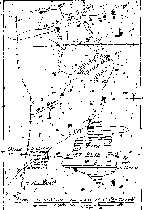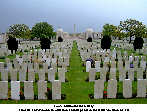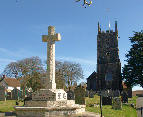
|
| HOME PAGE |
| MEMORIAL CROSS |
| HISTORY of the CROSS |
| ROLL of HONOUR |
| LINKS |
Private Edward James Jarvis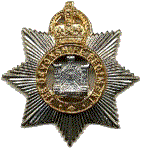 14418 9th Battalion, 14418 9th Battalion,Devonshire Regiment Died 30.09.1915 aged 25 Edward Jarvis was born in 1889 at Bondleigh, the eighth out of nine children of Daniel Jarvis, an agricultural labourer, and his wife Elizabeth Piper who had been born in Winkleigh. Daniel had been born in Cheriton Bishop around 1849, but it is not known how he may have come north to meet his future wife Elizabeth Piper, who was from a Winkleigh family. Daniel and Elizabeth first went to Crediton, then to North Tawton to finally settle in Bondleigh. Elizabeth’s mother, also Elizabeth, was born in Iddesleigh as was her husband John Piper, an agricultural labourer, and they came to live in Winkleigh. They had five children all born in Winkleigh and lived at Penson, the last of whom was Elizabeth born about 1852. However, by 1861 her father had died and Elizabeth was living together with just her widowed mother still at Penson. Her two brothers were carters at the nearby East Luxton farm. The two Elizabeth’s were still at Penson in 1871, but now with daughter Elizabeth’s illegitimate son John age 2 who had been born in Bondleigh. Daughter Elizabeth married Daniel Jarvis later that year and they immediately moved away. By 1881 Elizabeth had moved next door from Penson to Clapper, and with her was her daughter’s son John, who was never recorded with his mother. When Edward Jarvis’ father, Daniel, died in 1909 age about 60, his mother moved in with her daughter Emma, recently married and living at Newland Cottage Winkleigh. As with the majority of the labouring families in Winkleigh, after leaving school at 12 or 13, the boys began work on the farms, while the girls (unless they stayed at home to care for the younger children of the family) often went into domestic service, living away from home with their employers. In 1901 Edward, aged 12, was still at school, while his elder brother Richard, aged 14, was already working as a horseman and carter for Josiah Miller, a farmer at Gray’s Bridge. By 1911 Edward had obtained work as a farm labourer with Edwin and Sarah Pike at Parsonage farm, Nymet Rowland near Morchard Bishop, from where, presumably, he enlisted very early on in the war to join the 9th Battalion of the Devonshire Regiment. Edward’s elder brother Richard also served in the Devons and survived the war. The 9th (Service) Battalion was formed at Exeter on 15th September 1914 in response to Lord Kitchener’s call for the second hundred thousand (K2) to come forward. In its early days of training it was attached as Army Troops (i.e. not part of a numbered Division) to the 20th (Light) Division. In April 1915 the battalion left that attachment and was posted to France, landing at Le Havre on 28th July 1915. On the 8th August it found a permanent home with the 20th Brigade, 7th Division. The story of Edward Jarvis’ war can thus be traced by following the fortunes of the 9th Battalion from its formation. Edward had joined in the very first weeks of their preliminary training as a battalion of the New Army, and his medal record shows that he was awarded the Victory, British and Star medals after he was “Regarded as Dead” in France on 30 September 1915. The story is short and tragic. Posted to France with his battalion on 12 August 1915, Edward was killed a mere seven weeks later in his first major engagement, the battle of Loos, the culmination of the 1915 campaigns designed to break through the German trench system. Four days after the declaration of war on 4th August, Lord Kitchener, the new Minister of War, ordered mobilisation of the first of what turned out to be four New Armies, the first hundred thousand, K1. Accordingly, on 8th August the Devonshire Regiment ordered the voluntary enlistment of the first of the Devonshire Service Battalions, the 8th, staffed with a handful of officers and NCOs detached from the 1st Battalion to form a nucleus. Recruits flocked to Exeter to join the new battalion as the territorial battalions were already full to overflowing: so great was the enthusiasm that even old reservists seeking to rejoin came forward. Most were soon weeded out as too elderly for this new war. A few of these experienced old soldiers, however, did help to provide a few more senior NCOs for the time being. There were no uniforms, rifles or barracks, nothing but the utmost enthusiasm to get to France as soon as possible. Today the North Camp just outside Farnborough is a well-to-do housing estate blessed with excellent facilities. In 1914 it was a delightful area of common, and it was here (in those days named Rushmoor Camp) that the new 8th Battalion was billeted in tents for the remainder of the summer and early autumn, moving in early December into billets in the surrounding villages. On 7th September a second battalion, the 9th, was ordered, and came into existence in tents alongside the 8th at Rushmoor Camp. The two battalions were inseparable. Mobilized together they served together throughout the war. The first 500 men of the 9th arrived at Rushmoor from Exeter - but of these only 20 were Devonians, the remainder coming from Wales and Birmingham. There were of course no uniforms, rifles, equipment or even documentation - they had simply been put on various trains to fill the first available places left in K1! There was as yet no Parish Magazine in Winkleigh so that the main information about early enlistment in the village comes from the Winkleigh contributions to the Chumleigh Deanery Magazine from August onwards. Edward Jarvis’ name is not on the early lists, but contributions listing Winkleigh men ceased after November 1914 so we can only surmise that he joined sometime from December onwards. There is no mention of his enlistment date on his medal card and his army records have not survived. This means that by the time he joined, Rushmoor camp had been left behind and the 9th had moved to tented billets on the National Rifle Association’s Grounds at Bisley, attached to the 20th Division, and training on Pirbright Common. By now some 80 recruits from Devon together with large drafts from London and Birmingham had brought the battalion up to full strength, though still dressed in blue postmen’s uniforms. At the end of November the battalion moved into dry, if rather cramped quarters, Tournay barracks, Aldershot. Here, firing on the Ash Ranges was greatly welcomed, particularly when the first consignment of 100 real Service rifles arrived, to be lovingly passed from man to man on the ranges. On February 24th the battalion moved to Haslemere, but not before Edward, having surely arrived by this time, had been forced to endure a very testing ordeal. An inspection and review by Lord Kitchener accompanied by some French generals of several New Army battalions had been ordered to take place on the Chobham Ridges. The troops had to stand fast for hours in a bitter cold wind, below freezing point in sleet and snow, with six inches of snow and slush on the ground, the men wet to the skin and paralyzed with cold. It was a bitter foretaste of what was to come - the callousness for which the generals have been so frequently blamed in their regard not only for the welfare of their troops, but also for their very lives. The 9th Battalion had been left behind by the 20th Division when it went overseas on 9th May and instead moved from Haslemere to the 20ths old camping ground at Bordon. Here the 9th received advanced training in bombing, trench warfare and night operations, and were fully equipped with real Service rifles, ready to move overseas. On 27th July 1915 the 9th Battalion entrained for Southampton and that same day the first men sailed, the remainder following later in the evening. On 28th they disembarked, marched up to the training camp and three days later detrained at Wizernes, just behind the front line south of the Ypres salient, in the trenches captured at the battle of Festubert earlier in May 1915. On 8th August the 9th Battalion, in common with its sister battalion, the 8th, was attached to the 20th Brigade of the 7th Division to replace two Guards battalions that had left to form part of the new Guards Division. The 7th was an elite division, composed largely of regular army battalions. They were the first division to move into the line defending the Ypres salient and were still there when they were proudly joined by the two Devon Service battalions, who considered it a great honour to join an already famous division. The ground was marshy with little possibility of digging so that this was a ‘sand-bag line’ of breastworks built up above ground level. It had become a very quiet area of ‘live and let live’ with little real action and almost no casualties, a quiet introduction to the real business of war which lay ahead. Here the 9th Battalion remained, in and out of the line during August but early in September the 7th Division moved south of the La Bassee Canal to relieve the 9th Division in preparation for start of the battle of Loos, the final and greatest effort of the combined British and French armies in 1915 to break through the German lines, an attempt which in the view of many historians came very near to success. The 7th Division were allotted a crucial central area of the attack, a frontage due East of Vermelles with the Vermelles-Hulluch road on its right and the Quarries as the principal tactical feature opposite on its left (see the map on the right). In common with other battalions in the Division, the 9th Devons were digging a new front line in no-man’s land together with two assembly trenches behind it. Apart from this activity, however, and an occasional patrol there was little activity in the front line. The 20th Brigade were out of the line in rest from September 9th to 24th though there was much more work to be done out of the line than it, among other things bringing up the heavy gas cylinders that were to be used for the first time by the British army in an attempt to break through the German line. Final orders to the 9th Devons made their first objective Gun Trench, from which they were to move forward to hold and consolidate their second objective, the Cross Roads just West of Hulluch. At 5.30 am on 25th September an intensive bombardment crashed down on the German defences, the Germans replying by shelling the closely packed assembly trenches. Gas and smoke were released but the wind was not sufficient and the gas blew back along the British front, severely affecting the assault battalions, though the smoke did give them some support. The 8th Devons, or rather a remaining remnant of them, had actually reached the Cross Roads 400 yards West of Hulluch, but no reinforcements came up to push on into Hulluch itself, at that moment virtually deserted, as indeed also was the Cite St. Elie. Meanwhile the 9th Devons who had moved forward from their reserve trenches soon after 6.30, became scattered in their advance, having been delayed by finding Chapel Alley behind the front line choked with returning wounded, forcing them to climb out of the communication trench and move forward in the open. This exposed them to enfilade machine gun fire from the Quarries and from German field guns (see St Elei map on the right). Pressing on, however, the remainder finally reached Gun Trench where the Borders and a few stragglers were consolidating the position, and there they stayed. About mid-day 3 officers collected about 50 men, and moving along an old communication trench actually reached the Cross Roads where the few remaining men of the 8th Battalion were trying to survive, but they were not enough to push on into Hulluch by now reoccupied by German snipers and machine guns. Two battalions of the 21st Brigade came up as reinforcements but coming under intensive fire from Cite St. Elie reached Gun Trench but could go no further. At about 9.30pm the Germans counter-attacked the small force at the Cross Roads: the position was evacuated and the remainder fell back to Gun Trench. A fierce battle with much hand-to hand fighting then took place at Gun Trench, which was ultimately secured as described in the Battalion war-diary. The position was extremely serious, however, as the 7th Division had by this time lost the Quarries on the extreme left of its line. Throughout the next day, the 26th September, the now rather scattered remnants of the 8th and 9th Battalions hung on, the largest party of the 9th about 100 strong north of the road in Gun Trench. Here a detachment was sent back to fetch rations, ammunition and bombs. South of the Hulluch road a second group of about 90 men were in the continuation of Gun Trench. In the evening of 26th Gun Trench was handed over to the 21st Brigade, the 20th Brigade being withdrawn to the old British front line, the 8th to the North of the Hulluch Road, the 9th South of the road. Stragglers drifted in to swell the pitifully few survivors of the battle - now numbering about 150 of the 8th and just over 200 of the 9th. Even then, however, the ordeal of the 9th was not over. At 6.00pm on 29th orders were received to proceed again to the front line for a stand-to in expectation of a counter attack. The line was occupied until 2.30am, when the battalion was relieved by the Royal Welsh Fusiliers. At last on September 30th the two battalions moved back by Companies independently to Noyelles, and then by Battalion into billets in Beuvry. Here the cost was calculated: both battalions had been destroyed for the time being as fighting units. Both had been composed of eager volunteers who had come forward to join the New Armies, and of these few had survived their first battle. The 8th had lost 19 officers and 620 men killed, wounded or missing, the 9th lost 15 officers and 461 men, including 59 men killed, 76 missing and 326 wounded. Roll Call for the 9th on the morning of 30th September revealed the numbers of survivors (including the battle surplus and HQ staff that had not gone into action) standing at a battle strength of 12 officers and 325 men. Not all the details of this account are recorded in the battalion war-diary, the rest being taken from Capt. C.T. Atkinson’s account of the History of the Devonshire Regiment. The diary itself, written from notes compiled under great pressure, gives an hour-by-hour picture of the events. There is a section missing before 17th September, but the story is outlined from then on, including the approach to the front line area. 17th September: The battalion moved by Companies from Gonnehem to Fouquereuil. So, what of the fate of Edward Jarvis in the battle of Loos? He had survived the battle itself, although since we do not know in which Company he served we are unable to say whether by the night of 26th he was in the group in Gun Trench north of the Hulluch-Vermelles road or the group in Gun Trench south of it. He survived the counter-attacks and he survived the withdrawal on 26th to the old British front-line. But as we have seen at 6.00pm on 29th the battalion had been sent forward into the line again for a few hours and were not relieved until 2.30am on the 30th before moving back to Beuvry and comparative safety. Somehow on that night Edward Jarvis was missing, presumably killed by one of the shells that the Germans were sending over to fall in front of the original British line in order to impede reinforcements or hit survivors moving back. He simply never got back to Beuvry, and his medal card contains the information: Regarded as dead, 30th September 1915. As the survivors paraded for the morning roll-call on 1st October there was no answer to his name. With no known grave Edward Jarvis is commemorated on the Loos Memorial, panels 35-37, at the Dud Corner Cemetery, which records the names of over 2000 officers and men, the majority of whom fell in the Battle of Loos. Dud Corner Cemetery is located one kilometre West of Loos on the Lens to Bethune road, standing almost on the site of a German strong point, the Lens Road Redoubt, captured by the 15th (Scottish) Division on the first day of the battle. The name “Dud Corner” is believed to be due to the large number of unexploded enemy shells found in the neighbourhood after the Armistice. Loos was a comparatively early battle of the war. More terrible events were to follow on the Somme, Passchendaele, Arras, the storming of the Hindenburg Line, the huge casualties of 1918. But Loos has a special place in history. Some claim that a breakthrough was a very near miss, and that had reserves been available in the early afternoon of 25th Hulluch and Cite St. Elie could have been taken easily, and the German third line pierced for the cavalry to go through. In the event the reserves were too far back and were not committed until the next day when there was further slaughter. It is a point of discussion, however, that even if a breakthrough had been accomplished, the lack of really experienced staff officers could have made it almost certain that the success would not have been properly exploited. In the event, as a result of the debacle General French was recalled and General Haig became the supreme commander of the British armies in France. A full account of the Battle of Loos can be seen on the Long Long Trail web site at www.1914-1918.net/bat13.htm The eventually reconstituted 8th and 9th Battalions of the Devonshire Regiment could look back with pride on their first battle, in spite of their terrible losses, though ever afterwards if a man was missing at any time and the question was asked “Where’s so-and-so?” the answer always was, “He’s hanging on the wire at Loos“. The 9th had reached their first objectives in Gun Trench and held them in spite of losing their advanced position at the Crossroads. Sharing the credit with four or five other battalions the 8th had captured a battery of German guns, a fine achievement for a new battalion. Two of these guns were eventually presented to the County of Devon, handed to the Lord Lieutenant and entrusted to the city of Exeter at a parade including 12 officers and 40 men of the two battalions 16 November 2010 |
|---|
| [Top] | Back to MEMORIAL CROSS |
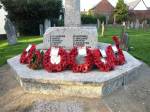
Click on an image for a larger picture |
RELATED TOPIC |
| GUNS CAPTURED AT LOOS BY 9th DEVONS |
